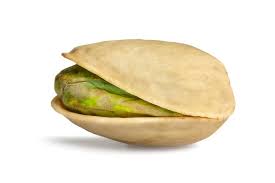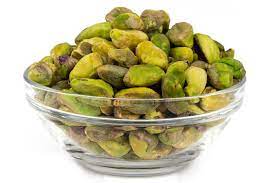
 The pistachio is a member of the cashew family.
The pistachio is a member of the cashew family.
It is is a small tree originating from an area that includes Afghanistan, Central Asia, and Iran.
The tree produces seeds that are widely consumed as food
The pistachio tree is native to Central Asia, including present-day Iran and Afghanistan.
The earliest evidence of pistachio consumption goes back to the Bronze Age.
The first commercial pistachio harvest in California took place in 1976.
Pistachio is a desert plant and is highly tolerant of saline soil.
Pistachio trees are fairly hardy in the right conditions and can survive temperatures ranging between −10 °C (14 °F) in winter and 48 °C (118 °F) in summer.
They need a sunny position and well-drained soil.
Pistachio trees do poorly in conditions of high humidity and are susceptible to root rot in winter if they get too much water and the soil is not sufficiently free-draining.
Long, hot summers are required for proper ripening of the fruit.
The tree grows up to 10 m (33 ft) tall.
It has deciduous, pinnate leaves 10–20 cm (3.9–7.9 in) long.
The plants are dioecious, with separate male and female trees.
The fruit is a drupe, containing an elongated seed, which is the edible portion.
The seed, commonly thought of as a nut, is a culinary nut, not a botanical nut.
The fruit has a hard, cream-colored exterior shell.
The seed has a mauve-colored skin and light green flesh, with a distinctive flavor.
When the fruit ripens, the shell changes from green to an autumnal yellow/red and abruptly splits partly open.
This is known as dehiscence, and happens with an audible pop.
Each mature pistachio tree averages around 50 kg (110 lb) of seeds, or around 50,000, every two years.
The pistachio tree may live up to 300 years.
The trees are planted in orchards, and take around 7 to 10 years to reach significant production.
Production is alternate-bearing or biennial-bearing,
Peak production is reached around 20 years.
Trees are usually pruned to size to make the harvest easier.
One male tree produces enough pollen for 8 to 12 drupe-bearing females.
Harvesting is often accomplished using equipment to shake the drupes off the tree.
After hulling and drying, pistachios are sorted according to open-mouth and closed-mouth shells, then roasted or processed by special machines to produce pistachio kernels.
In California, almost all female pistachio trees are the ‘Kerman’ cultivar, from Kerman, Iran.
A scion from a mature female ‘Kerman’ is grafted onto a one-year-old rootstock.
The kernels are often eaten whole, either fresh or roasted and salted, and are also used in pistachio ice cream, kulfi, spumoni, pistachio butter, pistachio paste, and confections such as baklava, pistachio chocolate, pistachio halva, pistachio lokum or biscotti, and cold cuts such as mortadella.
Americans make pistachio salad, which includes fresh pistachios or pistachio pudding, whipped cream, and canned fruit.
The shell of the pistachio is naturally a beige color, but it may be dyed red or green in commercial pistachios.
Most pistachios are harvested by machine and the shells remain unstained, today.
Pistachio nuts, raw
Nutritional value per 100 g (3.5 oz)
Energy 2,351 kJ (562 kcal)
Carbohydrates 27.51 g
Sugars 7.66 g
Dietary fiber 10.3 g
Fat 45.39 g
Saturated 5.556 g
Monounsaturated 23.820 g
Polyunsaturated 13.744 g
Protein 20.27 g
Vitamins Quantity %DV†
Vitamin A equiv.
lutein zeaxanthin 1205 μg
Thiamine (B1) 76% 0.87 mg
Riboflavin (B2) 13% 0.160 mg
Niacin (B3) 9% 1.300 mg
Pantothenic acid (B5) 10% 0.52 mg
Vitamin B6 131% 1.700 mg
Folate (B9) 13% 51 μg
Vitamin C 7% 5.6 mg
Vitamin D 0% 0 μg
Vitamin E 15% 2.3 mg
Vitamin K 13% 13.2 μg
Minerals Quantity %DV†
Calcium 11% 105 mg
Iron 30% 3.92 mg
Magnesium 34% 121 mg
Manganese 57% 1.2 mg
Phosphorus 70% 490 mg
Potassium 22% 1025 mg
Zinc 23% 2.2 mg
Other constituents Quantity
Water 4 g
Raw pistachios are 4% water, 45% fat, 28% carbohydrates, and 20% protein (table).
In a 100-gram reference amount, pistachios provide 2,351 kilojoules (562 kcal) of food energy and are a rich source (20% or more of the Daily Value or DV) of protein, dietary fiber, several dietary minerals, and the B vitamins thiamin (76% DV) and vitamin B6 (131% DV).
Pistachios are a moderate source (10–19% DV) of calcium, riboflavin, vitamin B5, folate, vitamin E, and vitamin K.
The fat profile of raw pistachios consists of saturated fats, monounsaturated fats and polyunsaturated fats.
Saturated fatty acids include palmitic acid (10% of total) and stearic acid (2%).
Oleic acid is the most common monounsaturated fatty acid (51% of total fat) and linoleic acid, a polyunsaturated fatty acid, is 31% of total fat.
Relative to other tree nuts, pistachios have a lower amount of fat and food energy but higher amounts of potassium, vitamin K, γ-tocopherol, and certain phytochemicals such as carotenoids, and phytosterone.
Pistachios are one of the very few ready-to-eat foods being a complete protein by containing all 9 amino acids.
United States Food and Drug Administration approved qualified health claim specific to consumption of seeds, including pistachios, to lower the risk of heart disease:
Evidence suggests eating 1.5 ounces (42.5 g) per day of most nuts, such as pistachios, as part of a diet low in saturated fat and cholesterol may reduce the risk of heart disease.
Although a typical serving of pistachios supplies substantial food energy their consumption in normal amounts is not associated with weight gain or obesity.
One review found that pistachio consumption lowered blood pressure in persons without diabetes mellitus.
A review found that pistachio consumption for three months or less significantly reduced triglyceride levels.
Aflatoxin is found in poorly harvested or processed pistachios.
Aflatoxins are potent carcinogenic chemicals produced by molds such as Aspergillus flavus and A. parasiticus.
The mold contamination may occur from soil, poor storage, and spread by pests.
High levels of mold growth typically appear as gray to black filament-like growth.
Eating mold-infected and aflatoxin-contaminated pistachios is unsafe.
Aflatoxin contamination is a frequent risk, particularly in warmer and humid environments.
Food contaminated with aflatoxins has been found as the cause of frequent outbreaks of acute illnesses in parts of the world.
Pistachio shells typically split naturally prior to harvest, with a hull covering the intact seeds.
Hulls protects the kernel from invasion by molds and insects, but this hull protection can be damaged in the orchard by poor orchard management practices, by birds, or after harvest, which makes exposure to contamination much easier.
Some pistachios undergo so-called “early split”, wherein both the hull and the shell split.
Damage or early splits can lead to aflatoxin contamination:
a harvest may be treated to keep contamination below strict food safety thresholds; in other cases, an entire batch of pistachios must be destroyed because of aflatoxin contamination.
Like other members of the family Anacardiaceae (which includes poison ivy, sumac, mango, and cashew), pistachios contain urushiol, an irritant that can cause allergic reactions.
